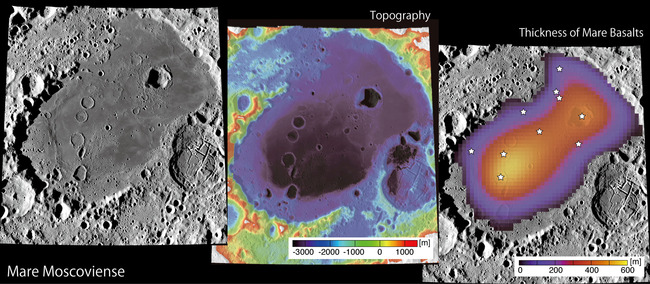Dr. Tomokatsu Morota, an Assistant Professor at the Graduate School of Environmental Studies, Nagoya University, studies the history of the Solar System based on planetary exploration data. In particular, he studies the Moon, which is the smallest planet-sized rocky body in the Solar System. Knowledge of the Moon is indispensable in tracing the history of the Solar System. Because the interior of the Moon cooled down soon after its creation, and it was neither influenced by magmatic activity nor plate tectonics, the Moon has preserved its primordial surface and evidence of environmental change in the Solar System. The craters on the Moon's surface are witnesses of asteroidal collisions, and by analyzing their size, number, and density, we can understand the frequency and time variation of these collisions, as well as the environment in which the early Earth was placed and the history of the Earth's formation. Dr. Morota's research traces circumterrestrial events in the past, and he uses this information to predict what will happen in the future. He was awarded the Young Scientist's Prize: the Commendation for Science and Technology by the Minister of Education, Cultures, Sports, Science and Technology in 2014 for his outstanding contributions to our knowledge of planetary evolution. Nagoya University Research briefly interviewed Dr. Morota, who has attracted widespread attention with his prize-winning research on the evolution processes of the Moon using data from a lunar orbiter, KAGUYA.
Why did you become a researcher?
"Since childhood, I have enjoyed watching the sky. In particular, I was interested in the Moon and planets that are visible to the naked eye. I majored in geoscience in college in which I learned about the importance of considering the Earth and surrounding astral bodies as one system; thus, I studied planetary science more broadly. Being a researcher was my dream from the days of my earliest recollection, and going into the workforce did not sit well with me. I wanted to research things in the natural world, not artifacts, and I always dreamed, 'How I wish I could make a living by being a researcher!'"

What are the challenges that you faced in the course of your research?
"Patience is an essential qualification for studying space. It can take more than a decade to obtain data after the initiation of a planetary exploration project. Generally, planetary exploration projects require a large budget and very large numbers of people, who are involved in roles such as the planning, the development of devices, mission operations, or data processing. If there is a single misstep, the project could be all over, and every effort would come to naught. As I watched the launch of the rocket in the KAGUYA (SELENE) project, I kept my fingers crossed. As a result of my patience, I enjoyed the most out of my research as I was working with the astonishing data acquired during planetary exploration."
What is your outlook for the future?
"I aim to provide a history of the planets as smoothly as possible. By analyzing interplanetary exploration data by various methods, such as numerical calculations, I would like to piece together the timeline of Solar System evolution. I have been involved in the KAGUYA (SELENE) mission for the past several years, and I currently am a part of the Hayabusa 2 project (a rocket to be launched in 2014) and the Moon Lander SELENE-2 (planning phase) project. I will help to deepen our understanding of the Solar System by the data obtained in these projects. Moreover, I would like to communicate with the public and explain the value of our research project, which is funded by the national budget."
What is your message to young students?
"To be a researcher, it is very important to broaden your outlook by learning various things. However, I believe that what is more important for researchers is to master a single subject and be an expert in that area. There is nothing more rewarding than being a researcher and you can delve into research on subjects that interest you. I hope that you will find what only you can do."
Links
Research Information
KAGUYA (SELENE)
Hayabusa 2
Moon Lander SELENE-2
JAXA Channel (YouTube)
Researcher Information
Nagoya University Faculty Member Profile
Graduate School of Environmental Studies, Nagoya University